With my thanks to Dr Evan Jones, of the Department of Historical Studies, University of Bristol, for bringing these images to my attention and for help with the background and discussion. I also thank Margaret Condon, Research Associate in the Department of Historical studies for her insight and further information about dragons, Henry VII and the royal charter. The document is held by and is the property of Bristol Archives.
The city of Bristol in the UK has a long history, much of it preserved in the ancient documents held by the Bristol Archives. Among these documents are dragons – and the dragons on this particular document are seen here for the first time.
In 1499, the Tudor king, Henry VII, granted a charter to the Corporation of the city, the original of which is preserved in the city Archives. A charter was a document that recorded judicial decisions and changes in the law, and for Bristol to be granted a charter was no small achievement. Rather like a large company bidding for a major contract, the city had to prepare its petition to the king to be awarded the charter; it took a lot of work and money
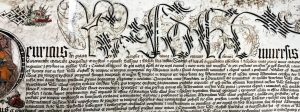
to submit its request. In Bristol’s case, the charter was to change the way the city was governed and its officials elected.
The document is of the form known as an illuminated manuscript. Written in Latin, it’s illustrated by a heavily decorated coloured initial letter, and on the top line, some of the capitals are embellished by small sketches of creatures and human faces.
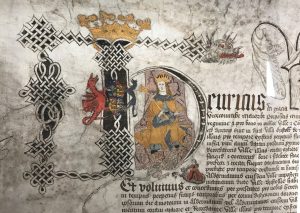
The image of the King himself is contained within the ‘H’ of his name in the title, written as a lower case ‘h’ (fig. 2).
At his feet, a tiny figure in a red robe is holding out a long document. This was the mayor of Bristol making the submission to the enthroned king, who is holding the orb and spectre of state; the king wears a crown that could have been originally rendered in gold leaf. There is a strange creature next to the mayor, nibbling the king’s feet. It’s not clear what this is, the shaggy mane implies it could be a lion, and lions were certainly known in England by then, there had even been two Barbary lions in the menagerie at the Tower of London, representing the majesty of the monarch.
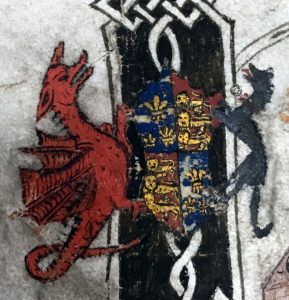
Henry’s coat of arms is shown on the left of the throne, forming part of the ‘h’ (fig. 3).
The shield is quartered in blue red and gold, with what looks now like a black creature with a red tongue, on the right, possibly a dog. Our Welsh readers will immediately recognise the red dragon to the left. The red dragon – also the emblem of Wales – is a symbol of Henry VII’s Welsh ancestry, traditionally the symbol of Cadwaladr, King of Gwynedd from whom Henry claimed descent, and was the emblem of the Tudor kings. This dragon is relatively consistent with the traditional Welsh dragon, which today appears on the Welsh flag; one foot is raised, the tail is looped and a faint mark implies the barbed tongue although it doesn’t look like it has a barbed tail, it’s possible the tail barb is black against the black background.
What looks now like a black dog on the right is actually a white greyhound, but on the document was probably rendered in silver which, over time, has tarnished to black. The white greyhound was also a Tudor symbol because it had been used by Henry’s father, Edmund Tudor, so the dragon and greyhound appear together supporting the coat of arms.
But back to the dragons!
The interlaced black pattern around the capital in figure 2 – known as ‘strapwork’ – ends upper right in the face of a dragon, with red eyes and a red mouth and tongue, long ears and spikes on the face and below the jaw.
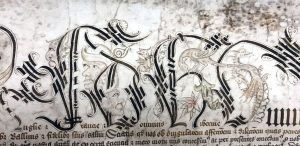
Other dragons appear in the illumination above around the title text (fig. 4)
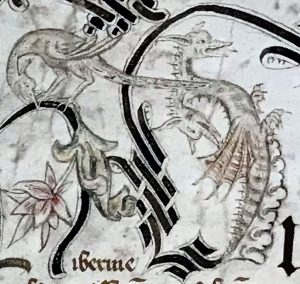
On the far right is what looks like a two-headed dragon looking to the right, behind the long tail of a bird (detail, fig 5). The bird is likely a peacock with its long tail feathers.
This dragon and the red dragon in the coat of arms could have been drawn by the same artist. The heads have long ears, and the shape of the face and the position of the eyes is the same; the mouth is pulled back in a grimace. The dragons have spines running along the neck and back all the way to the tail, and the wings are structured in the same way, like bats’ wings, with ribs and membranes between the ribs. It’s not clear whether the two-headed dragon has four legs or two; if there are four, the hind legs are not visible and, if not, the artist has drawn it as a two-headed wyvern, but the tail has interesting lateral stripes, implying the artist had a clear idea of what the dragon should look like
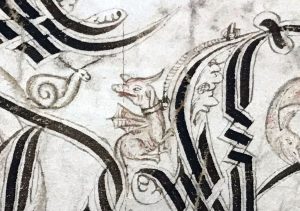
Figure 6Perhaps the most endearing of the images is the one in the centre, of the baby dragon and the snail (fig. 6.) It’s clearly a baby as the artist has drawn it with a large head relative to the body, big horns/ears and eyes, a small tongue and tail, and no spines. The wings are also smaller compared to the body. It wears a collar with a chain attached to a point to the upper right strapwork and the lines of the collar and ring are drawn more heavily than those of the body, emphasising it being constrained or tamed in some way. It’s possibly chaffing at the collar, peering at the smiling snail to the left, which could be read as taunting the dragon. It raises the question of who has tried to tame it – and why? And why is the snail there and what is it doing?
There are also human faces in amongst the drawings and in the left-hand sketch in figure 4, a bird is tweaking the nose of the rather grumpy looking man in the hat; the artists decorating such documents often show a darker sense of humour.
All the dragons are drawn well enough to be clearly identifiable as dragons. They’re drawn fairly consistently like this throughout the Middle Ages in Europe with the features seen in these dragons. The features such as the bat wings and the spines are still incorporated in dragon design today, a fascination with them that shows no signs of going away.

